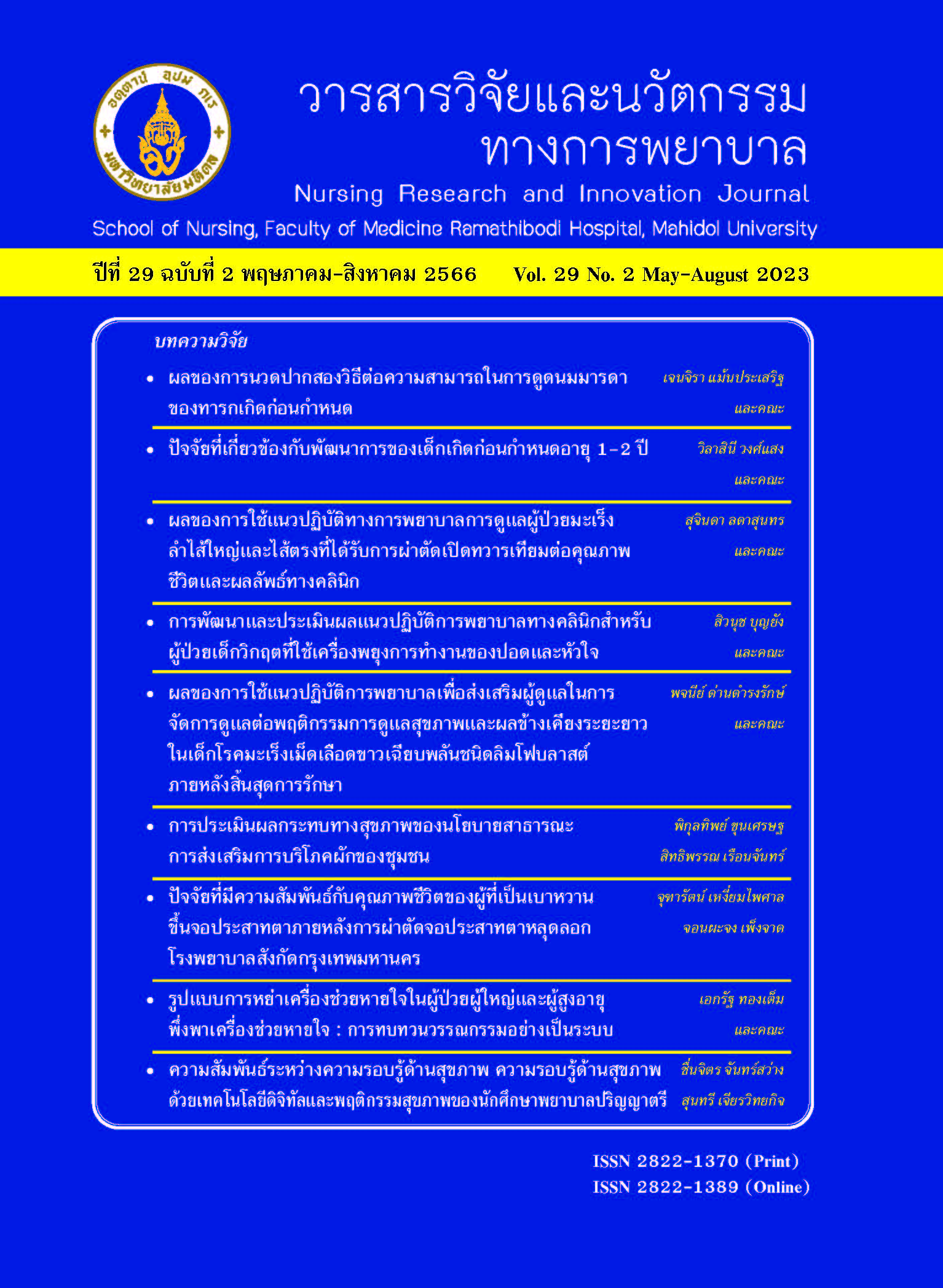Factors Related to the Development of Preterm Children aged 1-2 years
Main Article Content
Abstract
This cross-sectional descriptive research aimed to examine factors related to the development of preterm children aged 1-2 years. The subjects of this study were the mothers and preterm children aged 1-2 years at a newborn clinic and a very low birth weight clinic in a university hospital. The data were collected from June to November 2020. There were 78 subjects selected by purposive sampling. Data were collected using a personal information questionnaire and the Developmental Assessment for Intervention Manual. The data were analyzed using descriptive statistics and the Chi-square test. The study revealed that the normal developmental preterm children
were 71.79%, and the suspected developmental delays were 28.21%. The findings showed that the mostly suspected delayed development aspect was expressive language.The factors related to the development of preterm children aged 1-2 years were storytelling and breastfeeding with statistical significance. Therefore, the relevant agencies should periodically monitor the development of preterm children and advise mothers about age-related storytelling and promoting breastfeeding to promote the development of preterm children according to their age.
Keywords: Development, Developmental Assessment for Intervention Manual (DAIM),Preterm children
Article Details

This work is licensed under a Creative Commons Attribution-NonCommercial-NoDerivatives 4.0 International License.
บทความ ข้อมูล เนื้อหา รูปภาพ ฯลฯ ที่ได้รับการตีพิมพ์ในรามาธิบดีพยาบาลสาร ถือเป็นลิขสิทธิ์ของวารสาร หากบุคคลหรือหน่วยงานใดต้องการนำทั้งหมดหรือส่วนหนึ่งส่วนใดไปเผยแพร่หรือเพื่อกระทำการใด ใด จะต้องได้รับอนุญาตเป็นลายลักษณ์อักษรจากรามาธิบดีพยาบาลสารก่อนเท่านั้น
References
World Health Organization. Preterm birth [Internet].Geneva: WHO, updated 2017 [cited 2018 Mar 1].Available from: Available from: http://www.who.int/mediacentre/factsheets/fs363/en/.
March of Dimes. Premature Birth Report Card [Internet].2021 [cited 2022 May 21]. Available https://www. marchofdimes.org/peristats/tools/prematurityprofile.aspx?reg=99.
Ministry of Public Health of Thailand. HDC report [Internet]. 2019 [cited 2022 May 20]. Available from:https://hdcservice.moph.go.th.
Venkataraman R, Kamaluddeen M, Amin H, Lodha A. Is less noise, light and parental caregiver stress in the neonatal intensive care unit better for neonates?. Indian Pediatr.2018 Jan;55(1):17-21.
Platt MJ. Outcomes in preterm infants. Public health. 2014 May 1;128(5):399-403.
Losatiankit P, Kangkan W, Pupongpunkul K, Phanpong C, Saenjai M, Prasith-thimet T, Bunleang W,Chunhakhantarot P, Toopcham N, Ratnan Y, Janchua D.Situation of Thai Childhood Development in 2014. J.HEALTH Sci. 2017 Nov 1:S199-208.
Yuppayao Singarj. Growth and Development Outcome of Very low birth weight Outcome of Very low birth weight Infants at 18-24 mouths of age [Diploma of the Thai Subboard of Pediatric Neonatal and Perinatal Medicine].Bangkok: Queen Sirikit National Institute of Child Health;2009.
Skiöld B, Alexandrou G, Padilla N, Blennow M, Vollmer B, Ådén U. Sex differences in outcome and associations with neonatal brain morphology in extremely preterm children. J. Pediatr. 2014 May 1;164(5):1012-8.
Linsell L, Malouf R, Morris J, Kurinczuk JJ, Marlow N.Prognostic factors for poor cognitive development in children born very preterm or with very low birth weight:a systematic review. JAMA Pediatr. 2015 Dec1;169(12):1162-72.
Christmann V, Roeleveld N, Visser R, Janssen AJ, ReuserJJ, van Goudoever JB, van Heijst AF. The early postnatal nutritional intake of preterm infants affected neurodevelopmental outcomes differently in boys and girls at 24 months. Acta Paediatr. 2017 Feb;106(2):242-9.
Chang JH, Hsu CH, Tsou KI, Jim WT, Taiwan Premature Infant Developmental Collaborative Study Group.Outcomes and related factors in a cohort of infants born in Taiwan over a period of five years (2007–2011) with borderline viability. J Formos Med Assoc. 2018 May1;117(5):365-73.
Kersbergen KJ, Makropoulos A, Aljabar P, Groenendaal F, de Vries LS, Counsell SJ, Benders MJ. Longitudinal regional brain development and clinical risk factors in extremely preterm infants. J. Pediatr. 2016 Nov1;178:93-100.
Mahoney AD, Dooley DG, Davis NV, Stephens M, Falusi OO. Closing the Gap: Addressing Adversity and Promoting Early Childhood Development. Advances in Family Practice Nursing. 2019 May 1;1:183-99.
Timby N, Domellöf M, Lönnerdal B, Hernell O.Supplementation of infant formula with bovine milk fat globule membranes. Adv Nutr. (2017) 8:351–5.
Vannucci RC, Vannucci SJ. Brain growth in modern humans using multiple developmental databases. Am J Phys Anthropol. 2019 Feb;168(2):247-61.
Poonsin Charoensri. A Study of Development of Preterm Infant at Police General Hospital. JOPN. 2012;4(1):114-125.
Gesell A. The mental growth of the pre-school child: A psychological outline of normal development from birth to the sixth year, including a system of development diagnosis. Macmillan; 1925.
The Ministry of Public Health. Developmental Assessment for Intervention Manual (DAIM). Chiangmai:Rajanagarindra Institute of Child Development; 2015.
Chang JH, Hsu CH, Tsou KI, Jim WT, Taiwan Premature Infant Developmental Collaborative Study Group.Outcomes and related factors in a cohort of infants born in Taiwan over a period of five years (2007–2011) with borderline viability. J Formos Med Assoc. 2018 May1;117(5):365-73.
Wolke D, Johnson S, Mendonça M. The life course consequences of very preterm birth. Annu Rev Psychol.2019 Dec 24;1:69-92.
Coviello C, Keunen K, Kersbergen KJ, Groenendaal F,Leemans A, Peels B, Isgum I, Viergever MA, de Vries LS, Buonocore G, Carnielli VP. Effects of early nutrition and growth on brain volumes, white matter microstructure,and neurodevelopmental outcome in preterm newborns.Pediatr Res. 2018 Jan;83(1):102-10.
Michels KA, Ghassabian A, Mumford SL, Sundaram R,Bell EM, Bello SC, Yeung EH. Breastfeeding and motor development in term and preterm infants in a longitudinal US cohort. AJCN. 2017 Dec 1;106(6):1456-62.
Belfort MB, Anderson PJ, Nowak VA, Lee KJ, Molesworth C, Thompson DK, Doyle LW, Inder TE. Breast milk feeding, brain development, and neurocognitive outcomes:a 7-year longitudinal study in infants born at less than 30 weeks’ gestation. J. Pediatr. 2016 Oct 1;177:133-9.
DeMauro SB, Jensen EA, Bann CM, Bell EF, Hibbs AM,Hintz SR, Lorch SA. Home oxygen and 2-year outcomes of preterm infants with bronchopulmonary dysplasia.Pediatrics. 2019 May 1;143(5).
Benavente-Fernández I, Synnes A, Grunau RE, Chau V,Ramraj C, Glass T, Cayam-Rand D, Siddiqi A, Miller SP. Association of socioeconomic status and brain injury with neurodevelopmental outcomes of very preterm children. JAMA network open. 2019 May 3;2(5):e192914-.


